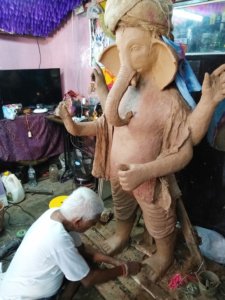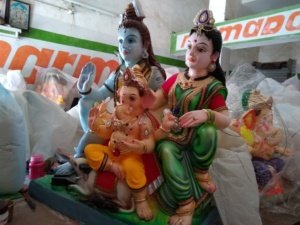
Ganesh Chaturthi is a time for feasting and revelry, but considering that Goa’s favourite Lord Ganesha is also known as the ‘God of Ecology’, it makes perfect sense to adopt eco-friendly modes of celebration
Ganesh Chaturthi is a festival marking family get-togethers – where familial relationships are nurtured and strengthened. Students who have had to move out to pursue further studies, professionals occupied with deadlines, and children especially wait for this particular occasion. Towards the end of the monsoon and the holy month of Shravan, as the aroma and colours of seasonal fruits start adorning the marketplace, a visible increase of cheer and enthusiasm is observed among the populace. Temple committees organise lucky draws; retail outlets hold festive sales and societies are abuzz with local competitions.
The arrival of the Bhadrapad month in the Hindu calendar marks the auspicious beginning of festive fervour. Houses are filled with melodies of ghumat aratis, beautifully decorated makhars and well laid out matolis, mouth-watering delicacies such as nevryos, ladoos and modaks; one visit from the lord of wisdom and everybody is on their toes. Ganapati – the God of wisdom, the Lord of all directions, the remover of all obstacles – is also known as the ‘God of Ecology’. Therefore, this festival is specifically closely intertwined with the nature. The makhar – the traditional fruit and vegetable decked ceiling – is made using the produce of the season.
Traditional Customs and Rituals
While Ganesh Chaturthi is celebrated with much pomp and grandeur, it also involves a lot of customs and rituals. Sometimes it so happens that the Chaturthi (fourth day of the fortnight of a Lunar Month), begins on the previous night and is over by the next morning. In such a case, the next day is observed as Ganesh Chaturthi. In general, the deity is brought home on the previous day. At that time, the face of the idol is covered with a piece of cloth or paper. On the day of worship, devotees wake up early and, after a bath, generally wear new clothes and start preparing for the day’s pooja. First, a pitcher (kalash) – filled either with water or rice grains – is placed in front of the idol. This is known as Purna Kumbha ceremony. The actual worship begins with the consecration ceremony in which the priest performs the Prana Pratishtha and invites the Lord to reside in the idol for the duration of the festival. In this period, the idol is considered to be the deity himself. This is followed by the Shodashopachara rituals, in which 16 distinct steps are followed. Sixteen upacharas like red hibiscus flower, marigold, durva grass, tulsi leaves, coconut, jaggery and modaks are offered. Throughout the rituals, devotees sing hymns from Rigveda, the Upanishads and Ganapati Atharvasheersha. The Ganesh stotra from Narad Purana is also recited. The arati of Ganapati is performed in the morning and evening. At the end of the ceremony, which can vary from one-and-a-half day to 21 days according to the Sankalpa of the host, the deity is taken in a procession after the Visarjana pooja and immersed in a clean water body like a well, river, lake or the sea.
The food is also a major highlight of the festival as Lord Ganesh is believed to be a foodie, so the devotees hosting Him, serve food prepared with love and devotion. Although the menu varies from state to state, it is customary to offer seasonal fruits and, among the sweets, modaks, ladoos and payasam are considered to be His favourites.
Ganesh Idols
In India, craftsmen begin sculpting clay models of Ganapati around 2-3 months prior to the event. These idols vary in size, ranging from a few inches to over 20 metres in height. The larger deities are generally made on order for community poojas while the smaller ones are brought home by devotees for private celebrations. A few days before the pooja, public organisations start building pandals while, on the home-front, people start cleaning their houses to host Vighnaharta Shree Ganesh. The place of worship is decorated with flowers, coconuts and banana leaves. The idol is generally brought home on the day before the ceremonies and placed in the designated place with the face covered with a saffron cloth.

On the fourth day of the waxing moon fortnight of the Bhadrapada month, the celebrations begin with the first light. Almost every household comes alive with the reverberations of bhajans sung in unison.
Ganesh Chaturthi celebrations, however, are not limited only to India, but extend to places with a fairly large population of Hindus. Nearer home, it is celebrated in the Terai region of Nepal and also in Sri Lanka. In the United Kingdom too, Sarvajanik Ganesh Mahotsav was started way back in 2005. Moreover it’s also celebrated in the United States, Canada, Singapore, Malaysia and Mauritius with great pomp
Over time, however, many in the pursuit of profiteering had forgotten an essential aspect of the festival. The makhars gradually started sporting plastic fruit; fresh flowers were replaced by paper and plastic ones too. Even the Lord’s idol itself was being made with the notorious PoP (Plaster of Paris), not to mention the chemical paints they are painted with. Loudspeakers and crackers came to be symbolic of the festival. The traditions that were meant to bind one to nature were gradually replaced by things that started severing these ties.
Some households, however, believe in simple rituals and traditions. They ensure that there are no loudspeakers or fireworks that could add to the noise. Instead, the celebrations are hosted on a grand scale by organising charity shows and contributing towards feeding the less privileged. Adhering to the initiative of going green, a popular trend observed today is the ‘Eco-friendly Ganesha’. A couple of years ago, a family in South Goa first chose to adopt an alternative means of visarjan. They installed an idol made of clay at their family home and then immersed the same in a drum full of water. Later, the same water was used in the garden for the plants. This way, the Almighty’s blessings stays within the family and nature prospers too.
Aware of how harmful non-biodegradable paints used on the idols can prove to be, residents are slowly moving over to eco-friendly paints and walking the path of change that maintains their religious sentiments, yet protects the surroundings.
In villages, when locals realised that these acts lead to contamination of water and could lead to scarcity of water, many decided to build artificial water tanks. Keeping thermocol and metals at bay, people are now welcoming biodegradable decorative items made from paper, cardboard, cloth and bamboo. This ancient legacy of being in sync with the nature, to nurture it rather than ruin it is slowly picking up.
According to Maruti Sadashiv Kumbhar, a sculptor who has hand-moulded exquisite idols out of clay for the last 48 years, “People seem to have realised the damage PoP idols cause to nature and the insult they do to Bappa by using such materials”
Emerging eco-friendly alternatives
Every year, one can observe innovative ways in which Ganesh deities are being created in a completely eco-friendly manner. A unique story is of Mumbai-based baker Rintu Kalyani Rathod, who last year made a 50-kilogram Ganesh deity of chocolate. She then immersed the deity in 90 litres of milk and the chocolate milk obtained was distributed to hundreds of underprivileged children. She began with her initiatives in 2011 by creating an idol made of sugar, followed by a Ganesha rangoli made of 3,000 cupcakes. Following suit, a few corporates are also adopting programmes of celebrating festivities with NGOs as a part of their corporate social responsibility.

Last year, people residing in a neighbourhood in Mumbai made a nine-foot tall Ganesha idol out of spices and newspapers. The Shri Sai Darshan Mitra Mandal in Malad crafted a 190-kg statue of Ganesh using 9 kgs of clove, 20 kgs of cinnamon, 6 kgs of chillies and 1 kg of mustard seeds.
Mumbai artist Dattadri Kothur creates eco-friendly Ganapati idols that are made from red soil and fertilisers, and contain plant seeds. At the end of the 10-day festival, the idols undergo a symbolic immersion. Instead of being immersed in a water body, the idol is placed in an accompanying pot and watered until it dissolves. Thanks to the lady finger or tulsi seeds sown in the pot, the idol grows back as a plant.
After immersion, aquatic life takes a huge hit, too. Keeping this in mind, Sprouts Environmental Trust is making idols that fish can eat. The brainchild of ecologist Anand Pendharkar, the statues are made with clay and stuffed with fish-friendly food such as corn, spinach, wheat and vegetable powder. The team has also reduced the size of the idols and decorated them with biodegradable, organic colours such as turmeric, sandalwood and gerua.
Moreover there are also sculptors who have taken to substituting cow dung for clay in the interest of preserving the environment. This greener method of producing Ganapati deities means that these can be immersed easily in lakes, and can also act as manure for plants.
Pune-based artist Vivek Kamble has been making alum Ganesha deities that can quickly dissolve in water. Since alum is often used for the purification of wastewater, Kamble says the statues help clean the water. The deities are designed with food colours, and weigh between 1 and 1.5 kg and are up to 10 inches tall.
Places like Marcel and Cumbharjua have huge statues of Lord Ganesh made from a variety of materials –rolls of paper, plastic straws picked off the road, broken glass pieces, coconut coir, sand and much more. A visit to these places provides the true spirit of Ganesh Chaturthi; the presence and craftsmanship of locally talented artists that thrives during this festival is immensely heartening to see, especially when they are going in the right direction.
The fervour of protecting the environment is growing gradually in all spheres. Some residential societies have started a system where they are moving towards sustainability by reducing the number of ingredients that get wasted, such as cotton wicks, oil, camphor, flowers, etc. A few families have even taken the initiative of installing the deity on a rotational basis. For instance, if it was installed at the residence of one person’s house, this year it will be at a neighbour’s, the following year will see another person host the Deity, and so on. Every individual decides and brings just one ingredient for the puja and everybody volunteers for the visarjan preparation.
Sustainability of the ecosystem is essential, and we must all strive towards achieving that in our own capacities. A proper tribute to Ganesh would be to contribute towards and maintain the nature He helped create





